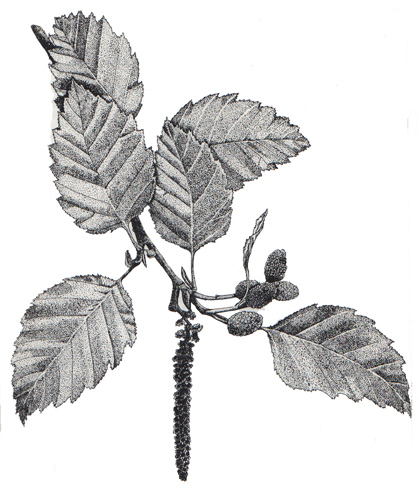

Alder
Alnus species
(Betulaceae)
Description:
The alders, of which Alaska has three species (Alnus crispa, A. rubra,and
A. ten uifolia), are large shrubs sometimes reaching tree
size. (Viereck) Their stems are not erect and rigid, but tend to bend under
the weight of the winter snow cover--an alder thicket becomes a maze of stems
at various angles. This growth form is distinctive, whether the shrub grows
alone or in a dense zone or band at treeline in the mountains.
Old fruits, conelike and dark brown, persist--they hang in clusters throughout the winter and into the next year. In summer appear leaves that are sharp-pointed at the apex, rounded or broadly wedge-shaped at the base; leaf edges are sharply and finely toothed, with long-pointed, nearly even or even teeth. Winter buds and summer leaves are slightly resinous, with a faint odor. The flowers are catkins and the roots, like those of legumes, often have root nodules--swellings containing berries that fix nitrogen from the air and enrich the soil.
Distribution:
Alders grow along roadsides, at treeline, in woods and
meadows, and on nutrient-poor, newly exposed soil along rivers.
Constituents:
Low molecular-weight phenol, neurotoxin, and an insecticide
are present, according to John Bryant. (personal communication)
Medicinal uses:
The inner bark of alder is Tanaina (Anchorage-area Native)
medicine; the Natives boil the bark and drink the tea to get rid of gas in the
stomach and to lower a high fever. (Kari) The astringent and powerfully bitter
bark infusion is used as a gargle for sore throat, to induce circulation, to
check diarrhea, and for eye drops.
Alder leaves are used to cure inflammation. Fresh leaves applied to bare feet are good for burning and aching; they are also used as a foot bath when brewed.
Bark of the red alder (A. rubra) of the coastal regions and western North America was used by Indians to relieve indigestion and as a tonic and alterative.
During the routine screening of southwestern Alaska plants for potential antitumor activity, the stem bark of A. oregona(same as A. rubra)showed significant antitumor activity. Lupeol and betulin were identified as the two constituents responsible for this activity. (Sheth et al.)
Other uses:
A fire made from green alder wood burns hot enough to use
for welding. Alder twigs and buds make up an important part of the food of ptarmigan.
In fall and winter the "seeds," or nutlets, are eaten by many songbirds.
Copyright © 1987 by Eleanor G. Viereck